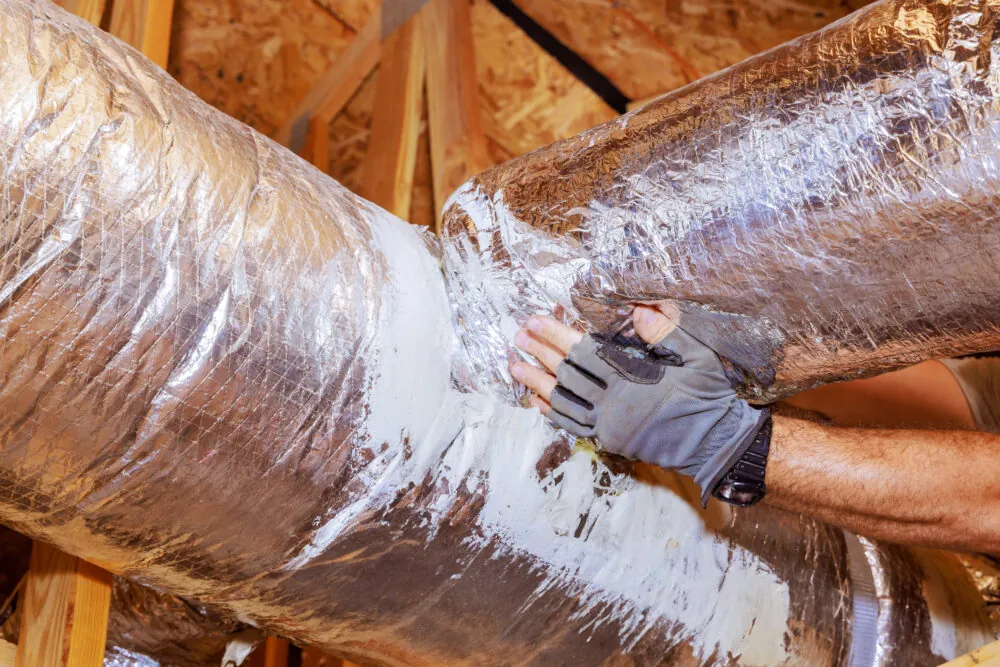How Does Ductwork Affect Your HVAC System?
Your home’s HVAC system uses ductwork to move heated or cooled air throughout each room. The ducts act like pathways, ensuring the air flows smoothly to keep your home comfortable. Well-designed ductwork is essential for keeping your home cozy in any season. If the ducts have leaks or aren’t installed correctly, your system might not work efficiently, leading to uneven temperatures and higher energy bills.
At Hopkins Air Conditioning, we specialize in ductwork repair. By improving your HVAC system, we aim to keep your home comfortable and reduce energy costs.
How do ducts work, and how do they affect your HVAC system?
How Does an Air Duct System Work?
Air ducts circulate air throughout your home to maintain a healthy and comfortable indoor environment. The system uses return ducts to pull air from your home into it. The air is then filtered, heated, or cooled. If your AC is on, hot air is extracted from the room and runs over refrigerant coils.
The cooled or heated air is then pushed back into your home through supply ducts and registers, which are openings in the ceiling or wall. As the new air enters the room, it creates a draft that pushes stale air out of return grilles in the walls or floor. This stale air is then transferred to another set of ducts that lead to the return plenum.
How Does Ductwork Affect HVAC Systems?
Ductwork is key to your HVAC system’s efficiency. Good ductwork design and installation help your system run smoothly. Poorly designed or leaky ducts can cause your system to work harder, leading to higher energy bills and uneven temperatures. By focusing on both the unit and the ductwork, we ensure your system runs at peak performance.
Factors that affect your AC’s performance include:
- Duct size: Ducts that are too small can restrict airflow, making the system work harder and increasing energy consumption. Oversized ducts can also reduce airspeed and circulation.
- Duct insulation: Insulation can help prevent condensation and moisture issues, improve energy efficiency, and help conditioned air reach its destination.
- Dust and debris: Dirty ducts can slow airflow due to friction, increasing heating and cooling costs.
- Design: A convoluted ductwork design with many twists and turns can restrict airflow and make the system work harder to distribute air.
- Leaks: Gaps or cracks in metal ducts can allow conditioned air to escape into unconditioned spaces, reducing HVAC efficiency.
Types of Ductwork Systems
Hopkins Air Conditioning specializes in HVAC duct systems, so we’re equipped to handle all types of ductwork, including:
- Galvanized steel ductwork: This is crafted from sheet metal formed into rectangular or tubular shapes. It’s coated with zinc for long-lasting protection against corrosion.
- Aluminum ductwork: This is also made from sheet metal, either formed on-site or prefabricated. It’s lighter than steel but offers comparable strength, durability, and performance.
- Fiberglass ductwork: Constructed from fiberglass sheets with built-in insulation, fiberglass ducts excel in thermal performance and reduce noise transmission.
- Flexible ducts: These ducts feature a wire coil covered with plastic and insulated with fiberglass. They’re easy to install and offer good thermal performance and noise reduction.
Your Trusted Ductwork Installation & Repair Contractors in Florida
Hopkins Air Conditioning is your trusted choice in West Palm Beach when improving your ductwork and HVAC system for peak performance. With over three decades of dedicated service since 1988, we’ve earned our reputation as the premier ductwork installer in the area. Trust Hopkins Air Conditioning for your ductwork needs and experience the difference firsthand.
Are you ready to upgrade your ductwork and save money on your utilities? Contact Hopkins Air Conditioning in Palm Beach County for your estimate today.
